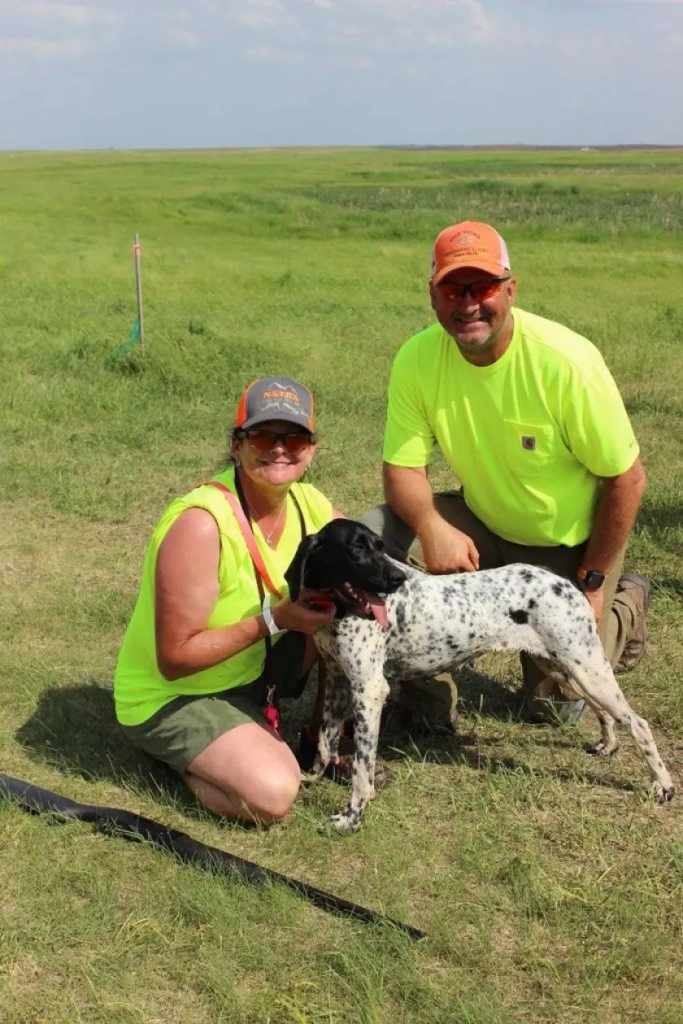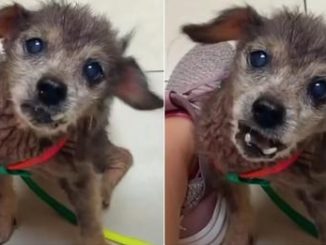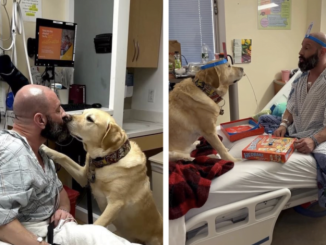
STARK COUNTY — Years of training have come to fruition for a Stark County couple whose dog was named National Shoot to Retrieve Association’s 2023 Dog of the Year on Oct. 28. Dean and Kristy Goodall’s dog, Cowpie, a 5-year-oldGerman Shorthair, took home the honor despite a recent infection that left everyone wondering if she would even survive.
The NSTRA competition, which was held in Amo, Ind., included 192 dogs, Dean Goodall said. He is Cowpie’s handler during competitions.
“You’re facing the best dogs across the entire country and to come out the last dog standing, it’s just an incredible feeling,” Dean Goodall said. “We’ve been so close so many times. But to finally win one, it’s just a dream come true.”
During the trials, two dogs compete against each other at a time. They are put in blinds with their handlers while five birds are planted on 40 acres of land. The dogs then have 30 minutes to find the birds, he said.

“We walk the field, there’s two of us, side-by-side, and your dog has to actually hunt for it,” Kristy Goodall said. “Then, when they smell a bird, they have to stop and point. Once they establish point, they can’t take another step until the bird’s in the air.”
The handler kicks around, until the bird flies into the air and then they shoot the bird. Once the handler shoots, they are not supposed to move, she said.
“Then the dog has to go find the bird, pick it up, bring it in and put it in your hand,” Kristy Goodall said.
Judges score the dog on several criteria, including obedience and retrieval, she said.
During the trials, Dean Goodall could tell Cowpie didn’t have the lung capacity she once had, due to an infection she endured after she competed last year. He wasn’t sure she would be able to finish, let alone win.
“When you’re out hunting, your dogs always have their noses in the grass running full speed through the grass,” Kristy Goodall said. “It’s kind of known to happen where they suck those grass seeds down into their lung tissue. Instead of going down through their esophagus, it actually lands inside the lung, and it creates a huge infection.”
The only solution for Cowpie was surgery, which required a veterinarian to open her rib cage to operate on the infected lung tissue. The surgery couldn’t guarantee she would survive. After the procedure was complete, Cowpie was then isolated and confined for two months while she healed.
“She slowly recovered and then she got pregnant and had puppies last summer,” Dean Goodall said.

The couple started getting Cowpie back into shape when her puppies were old enough to be sold.
“A year ago at this time, I didn’t think she’d be alive,” Dean Goodall said. “Now a year later, here she is winning the trial that almost killed her.”
The Goodalls, who live on a farm near Dickinson, have nine dogs. They train eight of those dogs for hunting and competition.
“You know, you start hunting in September and you’re done in December, and what do you do with your dog the rest of the year?” Dean Goodall said. “National Shoot to Retrieve Association simulates hunting conditions in a trial setting, but it’s a very competitive trial situation.”
They have been competing in the NSTRA trials for more than a decade. Although he quit for a few years, Kristy encouraged him to get back into competing in dog trials.
“I have that competitive drive and I wasn’t going to do this unless I could do it at the very top level,” Dean Goodall said. “So we got after it and we took it serious and we started pushing ourselves and trialing all over and getting better dogs and training better. And pretty soon we were placing in almost every national trial.”
He said Kristy’s success in training horses helped drive them to continue doing better with their dogs.

“Kristy’s hit the top of the world in the horse world — she’s won five world titles in horses,” Dean Goodall said. “Cowpie has finished fourth in the performance national trial before. She’s won two regional championships and now she’s the first dog we’ve owned that’s won a national.”
They run their dogs regularly to help keep them in shape, they said. All their dogs are well trained from basic commands to hunting commands.
“In the fall I’ve been wild bird hunting after work every day that I can get out in the field,” Dean Goodall said. “We end up training our dogs against each other, but they get tired of competing against each other. They know it’s practice. There’s a big difference between the intensity of an actual trial and going out and practicing.”
When they do well during trials, the Goodalls often reward their dogs with a steak or other treat. However, they say the trials are a reward in themselves, since the dogs love to do it.
Frightened Puppies Seek Refuge Under a Rock to Escape Human Presence

Once in a serene rural enclave, a small community of puppies came into the world, born to a mother dog who had sought refuge in a hidden grove. The tranquility of this environment should have been an ideal setting for a family of dogs, yet their lives were far from picturesque. Their mother, a determined leader among humans, had instilled in her offspring an intense fear of the outside world, a realm teeming with peril.

Their existence was a testament to the primal forces of fear and survival in the animal kingdom. To find solace and security, they had learned to depend on one another. Occasionally, these puppies, bearing echoes of their mother’s tenacity, would venture beyond the boundaries she had set, spurred by their innate curiosity.

It was under the shelter of a massive stone that these puppies would huddle together, away from the perceived threats of the outside world. Protected from harsh elements and potential predators, they would cautiously peek out from their secure den to observe the world beyond. Safely ensconced, they would watch the world go by, their tiny hearts racing at the sight of a distant human figure.

Their presence illustrated the potent influence of fear and survival instincts in the animal kingdom. They knew that to thrive, they had to remain concealed from the outside world, their small hearts quivering with trepidation. The stone, perhaps a relic from a bygone era, became their sanctuary, shielding them from the unseen dangers lurking beyond.
Over time, the transformation of these puppies was nothing short of extraordinary. Their initial dread of humans, born of past experiences and deeply rooted fears, gradually began to dissolve. Their encounters, filled with love and kindness, altered their perspective, and happiness began to supplant their previous apprehension.

The tale of these puppies served as a potent testament to the resilience of fear and survival instincts in animals. Their initial fear of humans was a defense mechanism, forged through past experiences and a deeply ingrained instinct to shield themselves from danger.

However, the unwavering patience and compassionate efforts of individuals determined to alter the course of these puppies’ lives began to yield fruit. Slowly but surely, the puppies began to conquer their fear and apprehension, forging trust and companionship between humans and their animal counterparts.



Leave a Reply